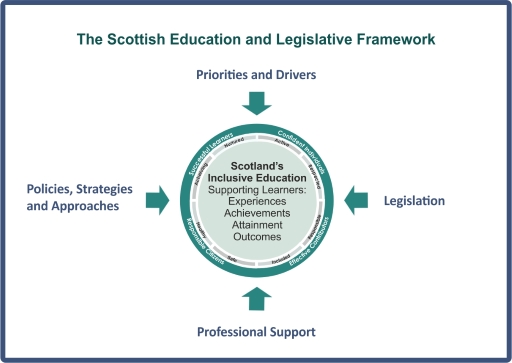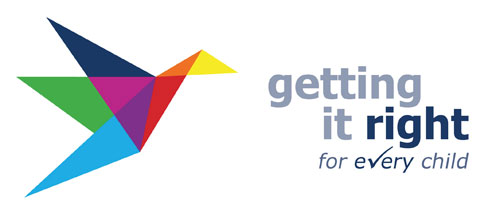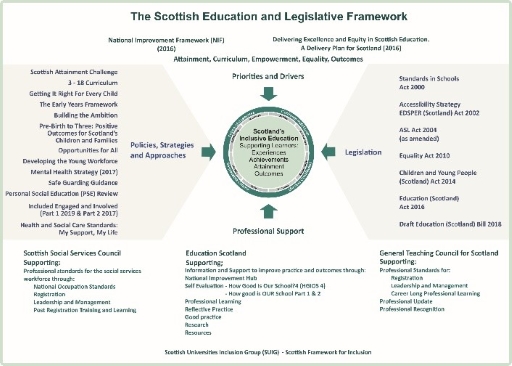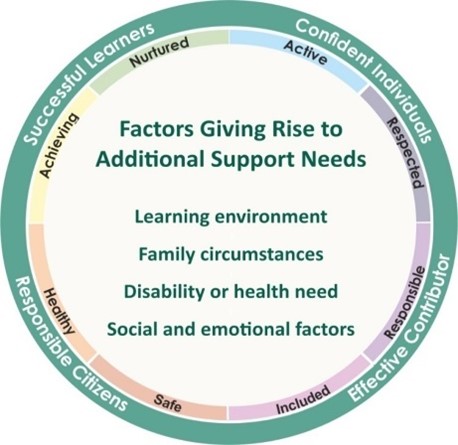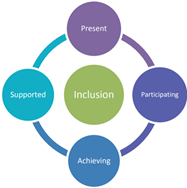Use 'Print preview' to check the number of pages and printer settings.
Print functionality varies between browsers.
Printable page generated Sunday, 23 November 2025, 5:05 AM
2 The Scottish context for autism and inclusion
2 The Scottish context for autism and inclusion
In this section, you will explore the following areas:
2.1 The Scottish context
As we consider the educational provision for autistic children and young people in Scotland, it is important to acknowledge and consider the national agenda, legislative and guidance context that local authorities, educational practitioners and health care professionals work within. Scotland’s education system is an inclusive one and designed to make sure that every child and young person is entitled to support to enable them to gain as much as possible from the opportunities that their education can provide.
Scotland’s ‘child-centred needs-led’ education system has been designed to ensure that the provision of support for a child or young person is not dependent upon them receiving a formal label or identification of need, such as autism, dyslexia or a physical disability.
The Scottish vision for inclusive education, which applies to all settings and for all children and young people, is set out below:
‘Inclusive education in Scotland starts from the belief that education is a human right and the foundation for a more just society. An inclusive approach which recognises diversity and holds the ambition that all children and young people are enabled to achieve to their fullest potential is the cornerstone to achieve equity and excellence in education for all of our children and young people.’
Presumption to provide education in a mainstream setting: guidance - gov.scot (www.gov.scot)
Children’s rights and entitlements are fundamental to Scotland’s approaches to inclusive education. It is supported by the legislative framework and key policy drivers including the ‘Getting it right for every child’ approach, Curriculum for Excellence and the Framework for Professional Standards for teachers. These are underpinned by a set of values aligned to social justice and commitment to inclusive education. This means that inclusive education should be the heart of all areas of educational planning.
Figure 5 below provides you with an overview of the Scottish education and equality context.
2.2 Legislative and policy frameworks
Legislation which places duties on schools and local authorities to support and provide inclusive education for learners in Scotland can be linked directly to the United Nations Convention on the Rights of the Child (UNCRC).
Our legislation ensures rights and entitlements for children and young people to education, support and wellbeing. There is a range of legislation and educational policies that places duties and expectations on schools and local authorities to ensure that they:
- promote a child centred approach to encourage every child to reach their ‘fullest potential’
- deliver an inclusive education
- support learners to achieve to the best of their ability
- do not discriminate against those with protected characteristics
- provide assessments when requested.
Within the ‘Getting it right for every child’ framework, there is an expectation that partnership working will ensure that children receive the right support at the right time from the right people. This includes families, education, social work, health and third-sector partners. Services need to work together in a coordinated way to meet the specific needs and improve the wellbeing of all children and young people.
Curriculum for Excellence
Curriculum for Excellence places learners at the heart of education. At its centre are four fundamental capacities. These capacities reflect and recognise the lifelong nature of education and learning. The four capacities are aimed at helping all children and young people, including autistic learners, to become:
- successful learners
- confident individuals
- responsible citizens
- effective contributors.
The purpose of the curriculum is encapsulated in the four capacities above.
The curriculum aims to ensure that all children and young people in Scotland develop the knowledge, skills and attributes they will need if they are to flourish in life, learning and work, now and in the future, and to appreciate their place in the world.
See the attributes and capabilities of the four capacities
See further information on Curriculum for Excellence and the Refreshed Narrative
Figure 6 below provides a more detailed overview of the national legislation and policy that underpins the Scottish educational context of inclusion and equality. It is not intended as an exhaustive list of all Scottish policy which refers to inclusion but gives a broad overview of some of the key legislation and policy documents.
Download a copy of The Scottish Context – detailed image
Looking at policy and legislation through the autism lens
Scottish legislation outlines a framework for all children to be supported, where necessary, to make sure they benefit from education and reach their full potential. This includes all learners who require additional support, for example, autistic learners. In Scotland, the term ‘Special Educational Needs’ is no longer used. Since 2004, we have used the term broad term ‘Additional Support’, which means:
any child who needs more or different support to what is normally provided in schools or pre-schools (from age 3) is entitled to additional support to overcome barriers to learning.
The legislation clearly states that an additional support need can arise for any reason and be of short- or long-term duration. Additional support may be required to overcome needs arising from learning environment, health or disability, family circumstances, or social and emotional factors as highlighted in Figure 7.
Autistic learners can require support across three factors: learning, disability, and social and emotional. The 2020 independent review of the implementation of the additional support for learning legislation highlighted the interconnection between the factors that give rise to additional support needs and that they are:
‘not mutually exclusive. This Review heard about increasing numbers of children and young people where issues due to Autism Spectrum Disorder (ASD) are compounded by social, emotional, behavioural problems linked to poverty and inequality’.
It is highly likely that all educational staff will work with and support an autistic learner at some stage. With this in mind, it is important for all staff to have an awareness of their professional duties and legislation with regards to inclusion and an understanding of how to support autism.
The Scottish Autism Strategy
The Scottish Strategy for Autism was created in 2011 to ensure that progress is made across Scotland in delivering quality services for children and adults on the autism spectrum. This is a ten-year national strategy for autism that addresses the entire autism spectrum and the whole lifespan of people living with autism spectrum disorder (ASD) in Scotland.
The Scottish Autism Strategy vision
Our vision is that individuals on the autism spectrum are respected, accepted and valued by their communities and have confidence in services to treat them fairly so that they are able to have meaningful and satisfying lives
Recent policies and legislation
You will need to download this file.
Download the summary of the Scottish Educational Legislative and Policy Framework, which provides an overview of the legislation and policies listed below.
- United Nations Rights of the Child (UNCRC)
- Disability Strategies and Pupils’ Educational Records (2002)
- Curriculum for Excellence
- Additional Support for Learning (Scotland) Act 2004 (as amended 2009) (ASL ACT)
- Code of Practice to support the ASL ACT
- Equality Act (2010)
- The Scottish Autism Strategy (2011–2018)
- ‘Getting it right for every child’ approach
- National Improvement Framework
- Scotland Delivery Plan
- Children and Young People Act (2014)
- Education (Scotland) (2016)
- Autism and the Equality Act (2010)
Activity 3
Autism and the Equality Act (2010)
Go to the Autism Lens on Policy and Legislation page on the Autism Toolbox to watch the film in which a Senior Policy and Insight Officer explains what the Equality Act means in practice when we are supporting autistic learners. There is an exploration of autism and disability and topics such as exclusions, reasonable adjustments for school trips or sports days, and after school clubs.
The link is also available on Education Scotland’s YouTube channel.
2.3 Inclusion and supporting autistic learners
The focus of this module and the Autism Toolbox is autism, but there is also an important focus on inclusive practice. Many of the highlighted approaches and resources are universal and inclusive by design and will help a range of different needs.
Scotland’s education system is designed to be an inclusive one for all children and young people with or without additional support needs to thrive in their community. This approach contributes to all children and young people’s understanding and appreciation of diversity and helps to build a more just and inclusive society. However, achieving this requires collaboration and support.
‘The central message is simple: every learner matters and matters equally. The complexity arises, however, when we try to put this message into practice. Implementing this message will likely require changes in thinking and practice at every level of an education system, from classroom teachers and others who provide educational experiences directly, to those responsible for national policy’.
To ensure that the needs of all children and young people, including those who are autistic, can be met as effectively as possible, it is important to retain diversity of provision, with mainstream education being complemented by special schools and specialist units.
Inclusive practice is important whatever the setting, whether it be within a mainstream or special school. There are four key features of inclusion that can be used to set expectations and evaluate inclusive practice in schools and early learning and childcare settings. The four key features of inclusion within the Scottish educational context are highlighted in Figure 8.
Together these four features support the delivery of inclusive learning environments for all children and young people that enable them to reach their full potential. Some aspects of the four features may interlink. For example, children and young people must be present in order to participate, so as a result, elements of practice associated with the key features may also overlap.
Activity 4
In your Reflective Log, note what the four key features of inclusion should mean for autistic learners.
Select here to see some examples.
| Present |
|
| Participating |
|
| Achieving |
|
| Supported |
|
Each school community is unique and variants will depend on certain factors, for example:
- geographical location
- the needs of learners in the school
- the Scottish Index of Multiple Deprivation (SIMD)
- ethos
- engagement levels from within and outside the school.
An inclusive school ethos for autistic learners, indeed for all children and young people, includes the creation of supportive learning environments and adapting learning environments to specific needs. Creating a positive learning environment through positive relationships and behaviour is the responsibility of everyone in each community of learning.
To help autistic learners feel safe, healthy and happy, active, nurtured, achieving, respected, responsible and included, all staff need to consider their own understanding of autism and inclusive practice, their approaches, and their style of learning and teaching. This will include:
- Genuine and effective learner participation.
- Educational planning and provision of the school curriculum, learning and teaching resources, approaches and all activities.
- Collaborative partnerships with parents and other professionals, including the full range of allied health professionals, to ensure that children's needs are appropriately identified and met.
- Responding to the need for a social curriculum for autistic learners is an essential component of successful inclusion in any setting. By recognising the value of meaningful social learning, teachers will be enabling autistic learners to function in and contribute more effectively in their own communities. This will help them to develop the competencies that are central to Curriculum for Excellence – successful learners, confident individuals, responsible citizens and effective contributors.
Many autistic learners only require minimal levels of support in class. Their needs will be met by a small number of reasonable adjustments within an inclusive classroom environment. This might include providing a visual timetable to enable them to better understand the structure of their day. A smaller number of autistic learners will need a more personalised, tailored approach.
Activity 5
In your Reflective Log, consider the following questions:
- How inclusive do I feel my practice is and how do I know?
- How inclusive do I feel my school community is and how do we know?
